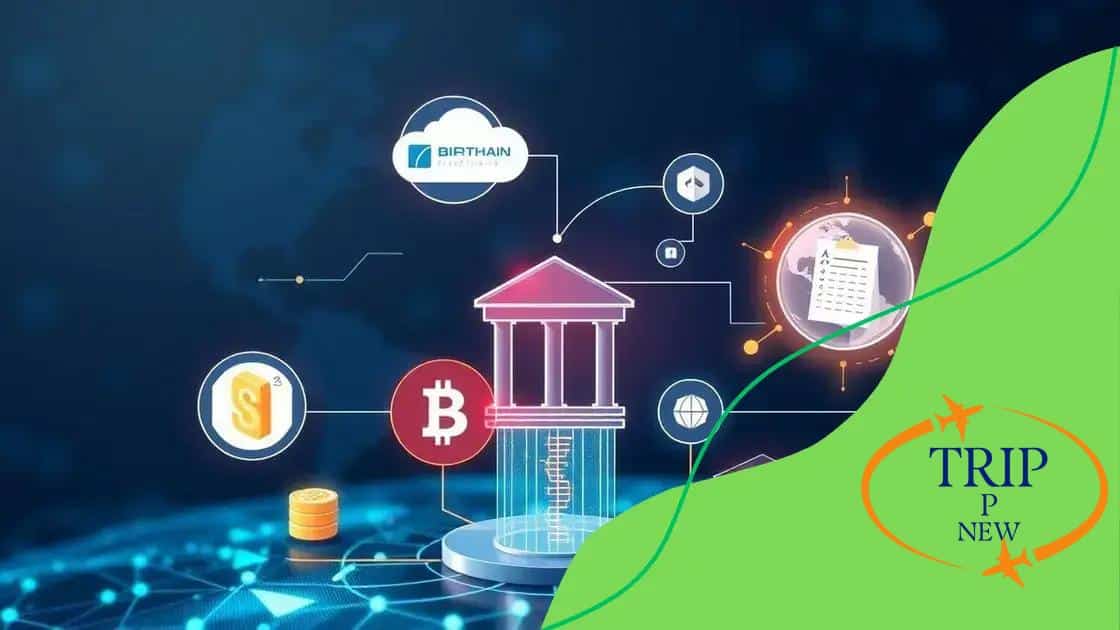Blockchain applications in finance: unlocking new opportunities

Anúncios
Blockchain applications in finance, including decentralized finance (DeFi) and central bank digital currencies (CBDCs), enhance transaction efficiency, security, and transparency while tackling challenges like scalability and regulatory compliance.
Blockchain applications in finance are transforming the way we think about transactions, providing unprecedented security and transparency. Imagine a world where payments are instant and fraud is nearly eliminated; that’s the promise of blockchain. Let’s dive into the exciting potential of this technology.
Anúncios
Understanding blockchain technology
Understanding blockchain technology is essential to grasp its impact on various industries. At its core, blockchain is a decentralized digital ledger that records transactions across many computers. This prevents the alteration of records retroactively, ensuring security and transparency.
Key Features of Blockchain
Blockchain technology has several defining features that make it unique and effective:
- Decentralization: Unlike traditional systems, it doesn’t rely on a central authority.
- Transparency: All participants have access to the entire chain, ensuring accountability.
- Immutability: Once recorded, transactions cannot be altered, enhancing trust.
- Security: Cryptographic techniques protect data from unauthorized access.
These features contribute significantly to the potential of blockchain in various sectors, particularly finance. Financial institutions benefit from enhanced security, while blockchain applications streamline processes such as cross-border payments and fraud detection.
Anúncios
Furthermore, understanding how transactions are verified within a blockchain is crucial. In essence, every transaction undergoes a verification process by network participants known as miners. They use powerful computers to solve complex problems, confirming transactions and adding them to the blockchain.
Applications Beyond Finance
While financial services are a primary use case for blockchain, its applications extend to supply chain management, healthcare, and even voting systems. In supply chains, it improves traceability and transparency across all stages, while in healthcare, it secures patient records and ensures privacy.
As we explore further into this technology, it becomes evident that blockchain has the potential to solve many existing problems in various fields. Whether you’re a business looking to innovate or just curious about technological advancements, understanding blockchain is the first step toward unlocking its vast potential.
Key benefits of blockchain in finance
The key benefits of blockchain in finance are transforming how transactions are conducted and managed. With its unique structure, blockchain brings valuable advantages to financial systems, which can enhance security, efficiency, and transparency.
Enhanced Security
One major benefit of blockchain is its enhanced security features. Each transaction is encrypted and linked to previous transactions, making it nearly impossible to alter. This creates a robust system resistant to fraud and cyber attacks.
- Cryptographic protection: Transactions are secured through cryptography.
- Decentralized authority: Eliminates single points of failure.
- Real-time monitoring: Enables instant identification of discrepancies.
Implementing blockchain technology can significantly reduce risks associated with fraud, building greater trust between parties.
Increased Efficiency
Blockchain also increases efficiency across financial transactions. By enabling faster processing times, it reduces the time taken for transactions from days to mere minutes. This is particularly useful for cross-border payments, which typically involve multiple intermediaries.
The automation of processes through smart contracts further enhances efficiency. These contracts automatically execute transactions once predetermined conditions are met. This minimizes the need for manual input, leading to quicker resolutions.
Greater Transparency
Another advantage is the level of transparency that blockchain provides. All users on the network can access transaction details, making all processes visible and traceable. This transparency fosters accountability, encouraging integrity among participants.
Additionally, businesses can analyze data trends by accessing historical records securely stored on the blockchain. This can lead to better decision-making and strategic planning in financial operations.
Overall, the benefits of blockchain in finance extend well beyond individual transactions. By improving security, increasing efficiency, and providing greater transparency, blockchain is set to revolutionize the financial industry, making it more reliable and user-friendly.
Real-world applications in banking

Real-world applications in banking showcase how blockchain technology is reshaping the industry. Banks are beginning to implement this technology to improve operations, enhance security, and innovate their services. These applications are not just theoretical; they are actively transforming traditional banking processes.
Cross-Border Payments
One of the most significant applications of blockchain in banking is in cross-border payments. Traditionally, these transactions can take several days and involve multiple banks and intermediaries, leading to high fees. With blockchain, these payments can be completed almost instantly, reducing costs and increasing efficiency.
- Reduced transaction fees: Lower costs due to fewer intermediaries.
- Faster settlements: Transactions occur in real-time.
- Increased transparency: All parties can trace the transaction path.
This streamlined process not only enhances customer satisfaction but also opens new markets for banks.
Fraud Prevention
Another essential application is fraud prevention. Blockchain offers a secure and transparent way to track transactions. Each transaction is recorded on a public ledger, making it easy to identify unauthorized activities.
Additionally, the decentralized nature of blockchain means that data is not stored in one single location, making it much harder for fraudsters to access sensitive information. Banks can use this technology to build trust and protect their customers.
Smart Contracts
Smart contracts are automated contracts that execute when specified conditions are met. In banking, these can be used for various purposes, such as loan processing and trade finance. By eliminating manual verification processes, banks can offer quicker service and minimize human errors.
For example, a smart contract can automatically approve a loan once all conditions, like credit checks and collateral, are satisfied. This streamlining leads to faster decision-making and improved operational efficiency.
With these real-world applications, it’s clear that blockchain technology stands as a powerful tool in banking. It holds the promise of making transactions more secure, efficient, and transparent, ultimately benefiting both banks and their customers.
Challenges of implementing blockchain technology
Implementing blockchain technology presents various challenges that organizations must navigate. While blockchain offers several benefits, the hurdles can be significant and require careful consideration.
Scalability Issues
One major challenge is scalability. Many current blockchain systems face difficulties in handling a high volume of transactions quickly. As more users join the network, the speed of processing can decrease, leading to delays.
- Network congestion: Increased traffic leads to slower transaction times.
- Higher fees: As demand grows, transaction fees can rise.
- Limited throughput: Some blockchains can only process a certain number of transactions per second.
These factors present barriers for banks and companies that require rapid transaction capabilities.
Regulatory Concerns
Another significant challenge lies in regulatory compliance. The legal landscape regarding blockchain is still evolving, and many governments are unsure how to regulate this technology. Organizations must navigate complex regulations while ensuring their compliance.
This can lead to uncertainty, preventing companies from fully adopting blockchain solutions. Frequent changes in regulations can also complicate the development process.
Integration with Legacy Systems
Integrating blockchain technology with existing legacy systems poses further challenges. Many financial institutions operate on older technologies that may not seamlessly connect with modern blockchain solutions. This can create friction in operations and reduce efficiency.
Organizations need to invest in updates and training to ensure a smooth transition. Failure to do so may result in inefficient processes and wasted resources.
Security Vulnerabilities
Security is often highlighted as a strong point of blockchain, but it is not immune to vulnerabilities. As with any technology, risks exist. Smart contracts, for example, can contain bugs leading to exploits.
Moreover, while the decentralization aspect enhances security, private keys must still be managed carefully. Losing these keys can result in permanent loss of assets.
Understanding these challenges is crucial for organizations considering the implementation of blockchain technology. By addressing scalability, regulatory, integration, and security issues, companies can better position themselves to take advantage of this innovative technology.
Future trends in blockchain finance
Future trends in blockchain finance suggest an exciting landscape as this technology continues to evolve. With advancements in blockchain, we are likely to see significant changes in how financial services operate and interact.
Decentralized Finance (DeFi)
One of the most notable trends is the rise of decentralized finance, commonly known as DeFi. This movement aims to recreate traditional financial systems, such as banks and exchanges, using blockchain technology.
- Peer-to-peer transactions: DeFi eliminates intermediaries, allowing direct transactions.
- Open access: Anyone with an internet connection can access DeFi services.
- Innovative financial products: New types of loans and investment opportunities are emerging.
DeFi is democratizing access to financial services, making them more inclusive.
Central Bank Digital Currencies (CBDCs)
Another significant trend is the development of central bank digital currencies. Many countries are exploring or piloting digital versions of their fiat currencies. CBDCs aim to enhance the efficiency of payment systems and provide a stable digital currency option for consumers.
This move could lead to more secure and faster transactions while reducing the costs associated with traditional banking. The use of blockchain in CBDCs can promote transparency and trust in central banking.
Tokenization of Assets
The tokenization of assets is also gaining traction. This process involves converting physical assets, like real estate or art, into digital tokens on a blockchain. By doing this, ownership becomes easily transferable and more accessible.
Tokenized assets can increase liquidity in markets where assets are typically illiquid. Investors can buy and sell fractions of assets, lowering the barrier to entry.
Regulatory Developments
As blockchain finance continues to grow, regulatory frameworks will evolve alongside it. Governments and financial authorities are starting to create guidelines to ensure security and compliance within the blockchain space.
These regulations may pave the way for wider adoption of blockchain by addressing concerns related to fraud, money laundering, and consumer protection. Establishing clear guidelines can boost confidence in the technology.
With these emerging trends, it is clear that the future of blockchain finance will be marked by innovation, inclusivity, and the potential for more efficient financial services. Keeping an eye on these developments will be essential for businesses and individuals looking to leverage this technology.
FAQ – Frequently Asked Questions about Blockchain Applications in Finance
What is decentralized finance (DeFi)?
Decentralized finance (DeFi) is a movement that aims to recreate traditional financial systems using blockchain technology, allowing for peer-to-peer transactions without intermediaries.
Why are central bank digital currencies (CBDCs) important?
CBDCs are important as they enhance the efficiency of payment systems and provide a stable digital currency option for consumers, helping to modernize financial infrastructure.
What are the benefits of asset tokenization?
Asset tokenization allows physical assets to be converted into digital tokens, increasing their liquidity and making ownership more accessible to a wider range of investors.
What challenges does blockchain face in finance?
Blockchain faces challenges like scalability issues, regulatory compliance, integration with legacy systems, and potential security vulnerabilities that need to be addressed for successful implementation.





